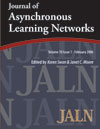ARE WE WHO WE THINK WE ARE? EPORTFOLIOS AS A TOOL FOR CURRICULUM REDESIGN
DOI:
https://doi.org/10.24059/olj.v17i4.395Keywords:
Program design, curriculum design, learning design, ePortfolios, formative assessment, signature assignments, learning outcomesAbstract
This promising practice focuses on the use of ePortfolios for formative assessment in the redesign and development of academic degree programs. The practice aligns with the Connect to Learning (C2L) Design Principles of Inquiry, Reflection, and Integration (IRI), which are nested within C2L’s “Catalyst for Learning” model for successful ePortfolio implementation. In 2011 Northeastern instituted an ePortfolio requirement for students enrolled in the university's Master of Education program. Systematic review of student ePortfolios as a collection informed planning for a 2012 Masters program redesign that began implementation in fall 2013. This redesign includes the articulation of a program vision, program- and concentration-level outcomes, course map with signature assignments designed to evidence outcomes, ePortfolio curricular integration, and shared foundational courses across four concentrations. The program redesign is intended to improve the integration of theory with professional practice; enhance the connection between academic and workplace-based learning; increase value for students in the portfolio development process; create greater outcomes transparency for faculty and students; and support ongoing improvement of the program.Downloads
Published
2013-12-23
Issue
Section
Invited Papers from the 19th Annual International Sloan-C Conference
License
As a condition of publication, the author agrees to apply the Creative Commons – Attribution International 4.0 (CC-BY) License to OLJ articles. See: https://creativecommons.org/licenses/by/4.0/.
This licence allows anyone to reproduce OLJ articles at no cost and without further permission as long as they attribute the author and the journal. This permission includes printing, sharing and other forms of distribution.
Author(s) hold copyright in their work, and retain publishing rights without restrictions






